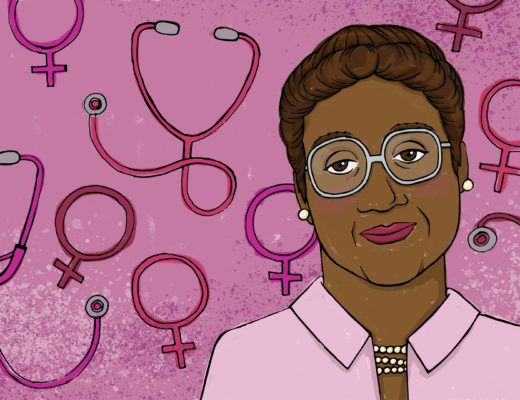Illustration by Catarina Moreno (www.catarinamoreno.com)
Look around. In nearly every boardroom, parliament, conference panel… you will find more men than women. Women represent half of the world’s population, but only a few will reach leadership positions. Men are doctors, women are nurses. Men are pilots, women are flight attendants. Men are professors, women are teachers. It’s a common theme across every sector in society. The men come first.
Gender inequality is so deeply ingrained in our society and or psyches that we don’t even see it. That women are secondary, weaker, inferior to men, unfit for leadership… has become our normal. Discrimination is easy to spot, it’s these subtle assumptions and biases that are harder to get rid of. Because if we’re not aware of gender inequalities, we continue passing them on across generations. But we can break this cycle.
First, we need to eradicate the obstacles that hold women back from pursuing their aspirations and fulfilling their true potential. Among these external barriers are sexual harassment, gender stereotypes, and subtle or direct gender bias and discrimination, including pregnancy discrimination and motherhood penalty. Second, we need to correct the wrong perception women have of themselves, which is an intrinsic barrier that is nevertheless a result of external societal pressures. How so?
As they grow up, girls receive subtle messages that women aren’t able or skilled for leadership. Even as adults, women are constantly reminded, often almost subliminally, that they’re dependent, needy, fragile, weak. Women are too emotional and family-oriented, and not ambitious or career-driven enough. You need a thick skin to lead, and women just don’t have what it takes. So we hear, and at some point we start telling ourselves and to each other the same thing, starting at a very young age.
These false assumptions gradually undermine women’s own confidence while biasing others against them. It’s a double-edge sword that pushes women into a secondary role in society.
We need to change these perceptions and prepare the next generation of women to challenge gender stereotypes and biases. Janet Rose Wojtalik, author of Raising Successful Daughters and The Seven Secrets of Parenting Girls, said:
“It is important that you start conversations early that will encourage your girl to pay attention to things that make her uncomfortable and to act when it happens. We do not want our girls to accept taking a back seat or being submissive”
How can we encourage our daughters to become confident, independent women and help them see their own strengths and talents? Below I summarise a few tips suggested by Wojtalik in the chapter “Seven ways to unlock female leadership” of Leading Women (Adams Media, 2015).
1- Praise and encouragement. Children are what we say they are. Praise your daughter for being hard-working, smart, determined, willing to try new things… rather than encouraging the idea that girls are princesses (who typically only aim to be pretty and marry a prince). If you tell your daughter she’s strong and smart she will believe you and become a strong, confident woman.
2- Independence. Although girls are just as capable as boys, parents have the tendency to help their daughters but they encourage boys to do things by themselves. This sends girls the message that they aren’t capable and teaches them to be dependent. Instead, encourage your daughter to figure things out on her own and make decisions, and then praise her for her efforts (even if she can’t do it).
3- Critical thinking. Make sure your daughter knows she’s entitled to have opinions and that they’re valuable. Ask her what she thinks about any subject, engage in a conversation, giver her ideas to consider. You can challenge her opinions but never dismiss them and don’t patronize her- the message should be, her opinions are valid.
4- Learning. Encourage your daughter to be curious and to learn new things, especially areas that are (wrongly) labeled by society as “boys things” like dinosaurs, legos, maths and science. Don’t fall into the trap of buying “girls toys” or doing “girly things”, this will just reinforce the stereotype and pass on the message that she is not supposed to like or can’t learn other things.
5- Authentic beauty. We all know it… our society sexualizes women and promotes the idea that in women (but not men), physical beauty equals worth. To help your daughter value herself for her intelligence, skills and talents, acknowledge them. Praise your daughter for being smart, rather than for being pretty. And be careful in how you see yourself too: if you complain that you’re fat or ugly, you are sending her the message that you value yourself less because of your physical traits. Value yourself and your daughter for who you are.
6- Education. Make sure your daughter knows she has choices and she can become anything she wants. She wants to be an astronaut? Encourage her! Show her examples of female leaders in various fields, including science, history, politics. Role models are important- you can’t be what you can’t see. And remember that YOU are her main role model.
7- Awareness. Talk to your daughter about gender stereotypes and the obstacles stopping women from fulfilling their true potential. Encourage her to speak up and challenge the false assumptions about women’s capabilities (or lack of thereof). To challenge gender stereotypes and bias, she has to be aware of them.
To conclude, it’s important to stress that women (or men) are NOT the problem. Women don’t need to be fixed. Gender inequality and women’s own perceptions are a result of our unequal society. If society would magically be fixed now, I wouldn’t need to write this article. But unfortunately, cultural change takes time, and in the meantime we need to prepare our girls to recognize and challenge the assumptions and biases that would otherwise reduce their chances of reaching their full leadership potential.




